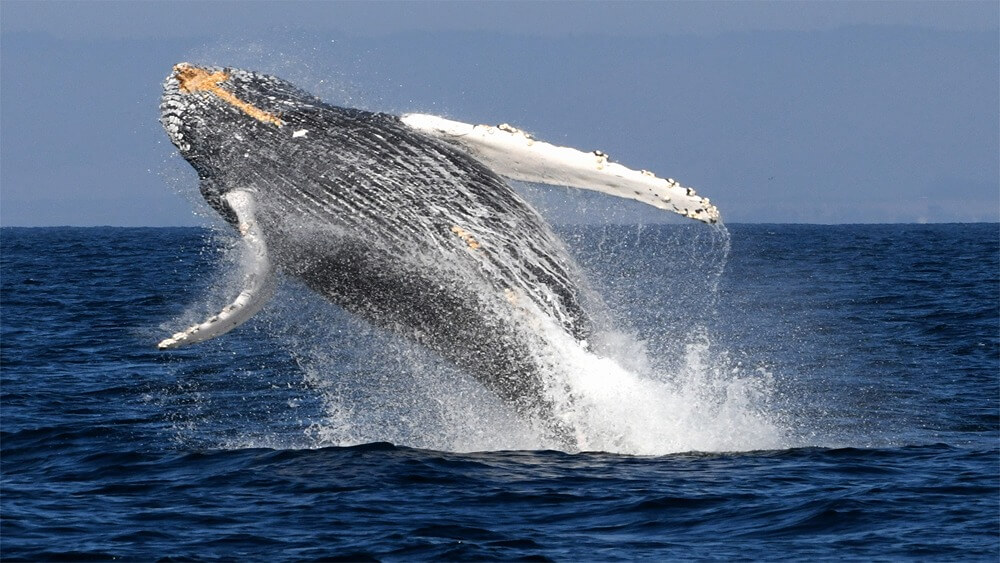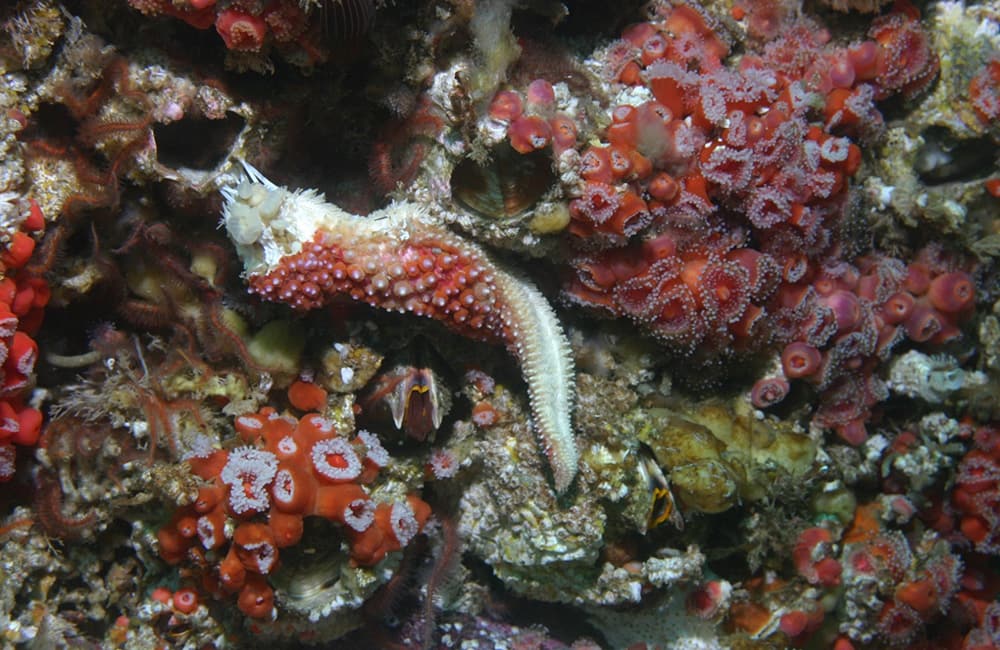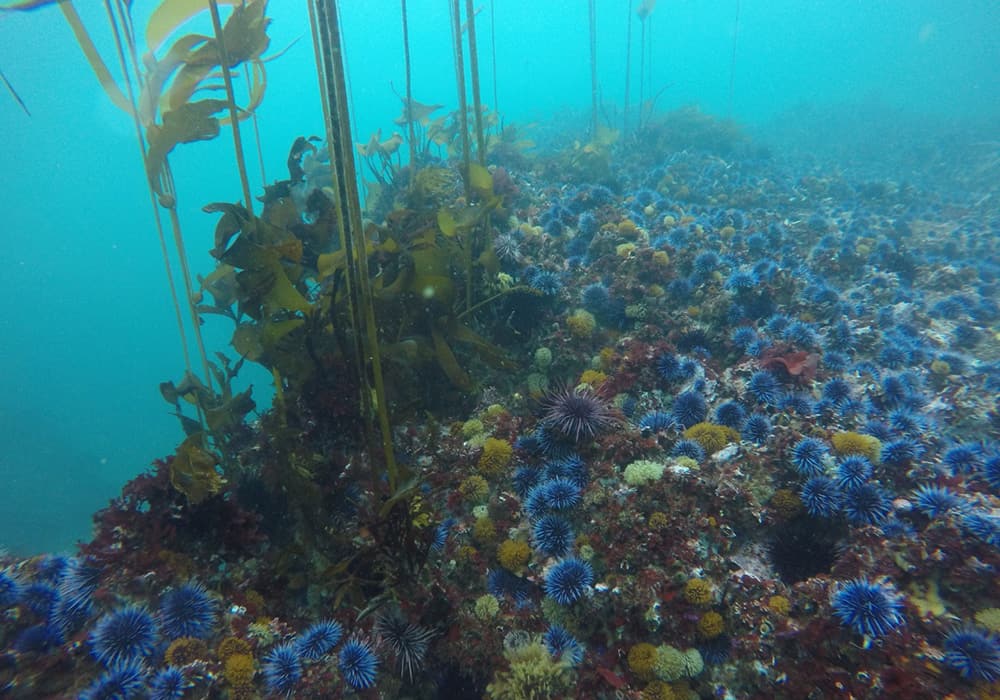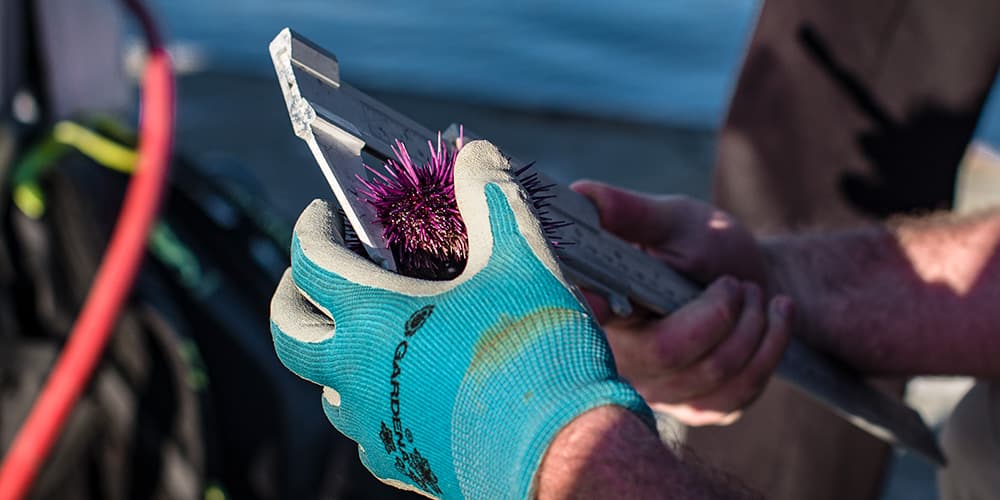June 2024
Editor’s Note: This article was revised on Feb. 10, 2025.
While bountiful and beautiful, Greater Farallones National Marine Sanctuary is not immune to human-caused pressures. These waters—which are a national treasure—have been protected for 43 years, yet the sanctuary’s latest condition report shows some impacts are already apparent due to changing ocean conditions. It is therefore necessary to continuously monitor and adapt management strategies moving forward.
The new condition report, written by sanctuary staff with input from experts and community partners, relies on the best available scientific data from 2010 to 2022 to outline trends in water quality, habitat, living resources, maritime heritage resources, and ecosystem services. This condition report will provide valuable insight for the upcoming sanctuary management plan review.
43 Years of Sanctuary Protections
Off the coast of California, west of southern Mendocino, Sonoma, Marin, San Francisco, and San Mateo counties, lies Greater Farallones National Marine Sanctuary. The area was designated in 1981 and the boundaries were expanded in 2015 to 3,295 square miles. This biodiverse and bountiful marine area supports an abundance of life within the California Current Ecosystem, including many endangered species. The sanctuary includes beaches, estuaries, rocky shores, kelp forests, deep-sea coral gardens, and a dynamic marine food web that supports local and regional economies.

The State of the Sanctuary
The report concludes that the overall condition of Greater Farallones National Marine Sanctuary ranges from fair/poor to good. The primary pressures that have and continue to impact sanctuary resources are changing ocean conditions, land use, marine harvest activities, vessel activity, marine debris, wildlife disturbance, and non-indigenous species. Below are some of the key takeaways from the report related to these threats:
Marine Heatwaves Are a Problem
The frequency and severity of marine heatwaves—extended periods of time where temperatures are unusually high—is increasing. This anomalous ocean warming has both direct and indirect impacts on marine organisms. The global average sea surface temperature has been rising for decades, which contributed to an increase in marine heatwaves observed along the U.S. West Coast.
A vast multi-year marine heatwave in the North Pacific created unusually warm ocean conditions that led to changes in the sanctuary ecosystem, including changes in species distribution and abundance, which had cascading effects throughout the ecosystem. For example, there was a notable decline in the nutritious krill that many predators feed on, and a proportional increase in less nutritious, gelatinous zooplankton. With less krill available, humpback whales switched to feeding on forage fish, which were compressed closer to the coast as a result of the marine heatwave. This caused an increase in the overlap of whales and human activities, such as shipping and fishing, making them more vulnerable to ship strikes and entanglement.


In addition, the heatwaves fueled harmful algal blooms that impacted wildlife and fisheries, leading to economic impacts.
“The severity and frequency of marine heatwaves are predicted to increase over the next century due to human activities, making it essential to identify ways to mitigate the impacts on marine ecosystems," said Danielle Lipski, research ecologist at Greater Farallones and Cordell Bank National Marine Sanctuaries.
Kelp Have Declined Over 90%
Kelp forests have experienced rapid and severe degradation and are one of the most vulnerable habitats in the sanctuary. Kelp forests provide critical habitat for diverse marine communities, play a significant role in storing atmospheric carbon, and contribute to the Blue Economy through commercial and recreational activities.
Greater Farallones National Marine Sanctuary was exposed to a series of compounding stressors that led to extensive kelp declines, starting in 2014. These stressors include a large-scale persistent marine heatwave, a massive die-off of sea stars, and a purple urchin population boom.


Sea stars were decimated by sea star wasting disease, which caused their prey—purple sea urchins—to flourish. Purple sea urchins eat kelp, and this population boom further contributed to the decline in bull kelp and hindered recovery after the heatwave.
The result: marine areas that were once vibrant kelp forests are completely barren of vegetation and dotted with thousands of purple orbs—areas referred to as “urchin barrens.”


“The loss of 90% of the bull kelp habitat is a significant shift with ramifications throughout the biological and human communities of the sanctuary, ” said Lipski.
This loss of kelp caused native endangered red abalone to starve. They just couldn’t compete with the ravenous purple sea urchins. And when the abalone starved, the red abalone sport fishery closed. This is a big hit to the local economy where the recreational abalone fishery brings in up to $44 million per year.
“A good way to put the severity of this kelp loss problem into perspective is to imagine if we lost more than 90% of our forested land in the Sierras,” the sanctuary’s education specialist, Jennifer Stock, explained.
Water Quality Health Risks—Some Fisheries Closed

Dungeness crab, salmon, rockfish, and groundfish are among some of the marine life commonly targeted by commercial and recreational fishermen in the area. Healthy fish and invertebrate populations depend on clean water to thrive. During the condition report period, the sanctuary experienced issues with biotoxins and contaminants that pose risks to human health. Of particular note, biotoxins affected water quality and fisheries in all regions of the sanctuary; advisories were issued to limit consumption of some fish species from Tomales Bay due to mercury contamination; and there were 131 instances of elevated fecal coliform bacteria at Tomales Bay that led to beach advisories.
The two biotoxins of major concern in the report are saxitoxin and domoic acid. Though the biotoxins do not typically make shellfish or fish sick, they will make humans sick if a person consumes an affected animal. Saxitoxin causes paralytic shellfish poisoning, and levels exceeded regulatory thresholds in offshore shellfish samples in most years throughout the Greater Farallones Condition Report period. The Dungeness crab fishery also experienced temporary closures due to domoic acid in 2015–2018, which causes amnesic shellfish poisoning. In mild cases of human consumption, domoic acid can cause dizziness, vomiting, and diarrhea, and in severe cases can cause breathing complications, seizures, or death.
So how do these biotoxins make their way into our seafood? Through harmful algal blooms. When a “bloom” of phytoplankton occurs, shellfish and fish consume large numbers of them. The domoic acid that affected the Dungeness crab fishery is produced by a group of naturally occurring diatoms (a type of phytoplankton), while saxitoxins that affect shellfish are produced by certain marine dinoflagellates (another type of phytoplankton). Harmful algal blooms are occurring more frequently for longer durations due to environmental shifts, raising concerns about biotoxins and fishery closures at Greater Farallones National Marine Sanctuary.

Dick Ogg, a commercial fisherman and member of the Greater Farallones and Cordell Bank National Marine Sanctuary Advisory Councils, has been fishing in the area for about 50 years. Ogg is from the small fishing community of Bodega Bay adjacent to the sanctuary, and says the closures had a direct impact on his community.
“Our whole industry is fishing—that’s it. Dungeness crab is 90% of our income in this area and it’s all made during a very short window,” explains Ogg. “During the closure, fishermen had no income.”

The impacts from harmful algal blooms are felt far beyond the pockets of fishermen—having a ripple effect throughout the local economy. “It’s an impact on the markets, the gas stations, restaurants, the vacation rentals…it has a tremendous trickle-down effect,” Ogg says.
Each of the issues mentioned above might be manageable on their own, but when multiple stressors occur all at once, the pressure on resources increases. Sanctuary managers are not able to address changes in ocean conditions on a large scale, but they can find ways to reduce the non-climate stressors to help alleviate some of the pressure on resources.
Managing a Sanctuary in a Changing Ocean
NOAA’s national marine sanctuaries are our nation’s most significant natural and cultural marine areas that are conserved for future generations. These special places are also “living laboratories” that offer opportunities to research and understand the changes taking place throughout our ocean and Great Lakes.
“The first step in addressing environmental shifts is to understand it,” said Lauren Wenzel, director of NOAA’s Marine Protected Areas Center.
By understanding how much and how fast conditions are changing, sanctuary leaders can then take actions to help the resources within the sanctuary adapt to a changing ocean.
“Greater Farallones National Marine Sanctuary provides a globally important example of how environmental challenges can be successfully addressed within marine protected area management through actions such as bull kelp restoration, native oyster restoration, and coastal sediment management projects," said Wenzel.

NOAA uses sanctuary condition reports as a standardized tool to look holistically at the status and trends of national marine sanctuary resources and ecosystem services. The report is then used to determine whether current management goals are being achieved and to determine how to prioritize updates to future management strategies.
Sanctuary staff also use data from sanctuary condition reports to create education and outreach products, such as the Blue Carbon Communication Toolkit, to educate the public about threats to the marine environment and the importance of conserving blue carbon habitats, such as kelp. “We want the public to know and care about the changes being observed, and weigh in on the best approaches to actively eliminate and reduce risks to the sanctuary ecosystem,” explains Stock. “Condition reports are one of a number of tools the sanctuary uses to foster public awareness and participation in sanctuary management."
The upcoming Greater Farallones and Cordell Bank National Marine Sanctuaries management plan review will invite the public to provide input on how best to prioritize management approaches in the sanctuary over the next five to 10 years. The sanctuary will announce a public comment period on their website and social media to invite public participation when the time comes.
Rachel Plunkett is the content manager and senior writer-editor for NOAA’s Office of National Marine Sanctuaries
For media inquiries, contact Jennifer Stock, jennifer.stock@noaa.gov.

